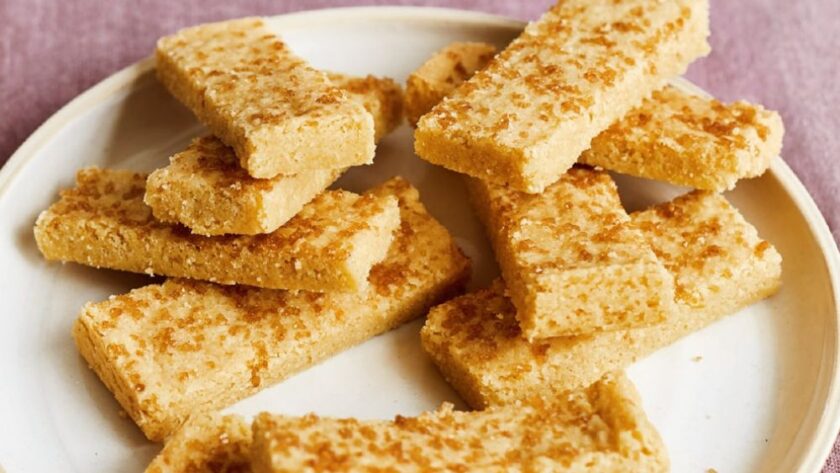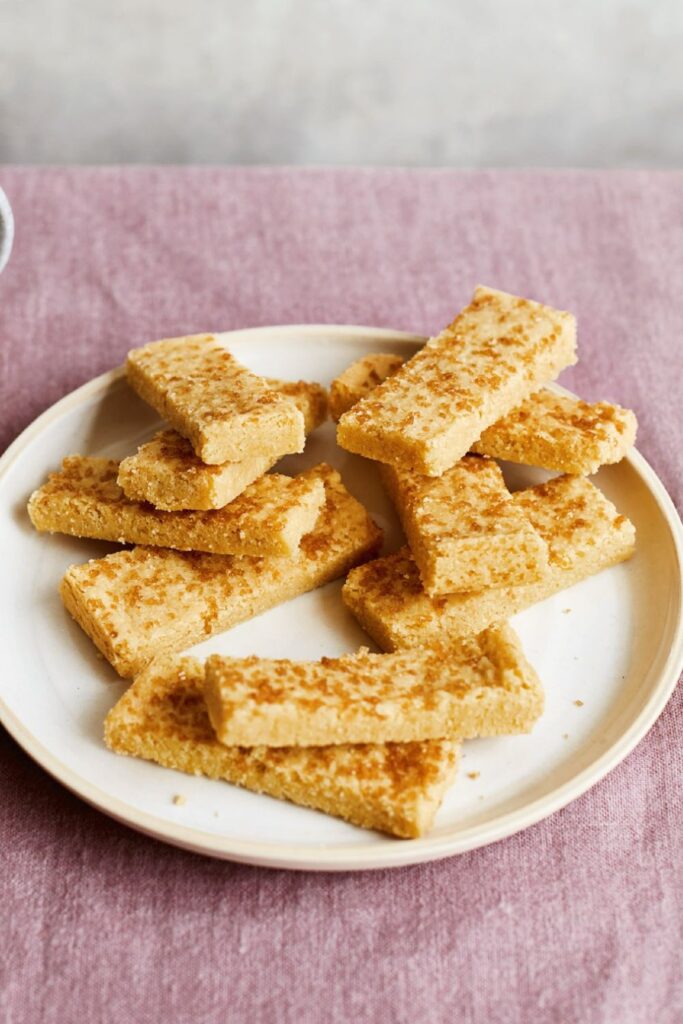I baked these orange shortbread fingers on a rainy Tuesday when I needed a bit of sun—but had none to speak of. I’ve made plain shortbread plenty of times, but adding orange zest? That was new. And to be honest, I thought it might be a bit much. But the moment that buttery dough hit the oven, the whole kitchen smelled like candied sunshine.
Here’s the thing that nearly ruined it: I rushed the chilling. Big mistake. My first batch spread too much, and I ended up with what I can only describe as one giant citrus biscuit tile. Still tasty, but a nightmare to slice. Let me show you how I fixed that—and why this version is now my go-to for teatime trays and edible gifts.
WHY THIS ONE WORKS SO WELL
There’s a quiet genius in using semolina. Most shortbread recipes go all-in on plain flour, but the semolina here gives it that gently sandy texture—like something you’d get from a posh bakery. The butter, as always, is doing heavy lifting, but it’s the orange zest that makes people stop mid-bite and go, “Ooh, what’s in this?”
Most recipes shy away from using zest in shortbread, probably to keep it ‘classic’. But Mary doesn’t mess about—just one orange, finely grated, and it transforms the whole bake.
INGREDIENTS + WHY THEY MATTER
- Semolina (100g) – Adds a delicate crunch and sandy texture. I tried once without it, and the fingers were too soft and floury. Not the same.
- Caster Sugar (100g) – Dissolves smoothly and sweetens without grittiness. I wouldn’t swap it for granulated unless you like crunch.
- Plain Flour (225g) – The base structure. Don’t use self-raising; it puffs, and you’ll lose the firm, buttery snap.
- Butter (225g) – Unsalted, always. Use fridge-cold cubes for best texture. Once I used a spreadable butter—regret. Too greasy.
- Orange Zest (from 1 small orange) – The citrus lift! Adds brightness without liquid. Don’t skip it, and zest right before using.
- Demerara Sugar (25g) – Sprinkled on top. It bakes into a caramelised crust that’s borderline addictive.
WANT TO CHANGE IT UP
- Gluten-Free: I tested with Doves Farm plain GF flour plus fine polenta instead of semolina. A bit more crumbly, but still held up.
- No Orange? Lemon zest works too. I’ve also tried it with ground cardamom instead—lovely, but a completely different vibe.
- Vegan Option: I tried with Flora Plant Butter and it worked surprisingly well, though they browned a bit quicker.
MISTAKES I’VE MADE (AND HOW TO AVOID THEM)
| What Went Wrong | Why It Happens | How to Fix It |
|---|---|---|
| Dough spread in oven | Didn’t chill the dough long enough | Chill at least 30 minutes—cold is key |
| Edges cracked when slicing | Waited too long after baking | Slice while still warm—not hot, not cold |
| Uneven texture | Used softened butter, not cubed cold | Use cold, cubed butter from the fridge |
HOW TO MAKE MARY BERRY’S ORANGE SHORTBREAD FINGERS
- Preheat your oven to 180°C (160°C fan)/Gas 4. Butter a 23 x 33cm Swiss roll tin well—especially the corners.
- Make the dough: In a food processor, pulse semolina, caster sugar, flour, butter, and orange zest. It’ll look crumbly at first, then suddenly clump into a soft ball.
- Press into tin: Pat it down with the back of a spoon. Try to get an even layer—uneven thickness means uneven bake.
- Chill for 30 minutes in the fridge. Don’t skip this, or your shortbread will rebel.
- Sprinkle demerara sugar evenly on top. Pop into the oven and bake for 25–30 minutes, until just pale golden (not brown).
- Cool slightly—about 5–10 minutes in the tin—then cut into 36 fingers. I go 3 across, 12 down. Use a sharp knife or palette blade.
- Cool completely on a wire rack. Try not to eat them all warm. (I fail at this.)

TIPS FROM MY KITCHEN
- I use a metal tin, not ceramic—it crisps the base better.
- My fan oven runs hot, so I start checking at 23 minutes.
- Zest the orange over the flour mix so no oils get wasted.
- Don’t press the dough too hard into the tin—just enough to smooth the surface.
STORAGE + SERVING
- Stays crisp in an airtight tin for up to 1 week. Don’t refrigerate unless it’s boiling hot in your kitchen.
- Freezes beautifully—wrap well and freeze for up to 3 months. Thaw uncovered for best texture.
- Serve with Earl Grey, lemon posset, or good vanilla ice cream. I once paired them with an espresso martini—no regrets.
FREQUENTLY ASKED QUESTIONS
Q: Can I make these without a food processor?
A: Yes. Just rub the butter into the flour mixture by hand until it forms a dough. Takes a bit longer, but works perfectly.
Q: Why use semolina in shortbread?
A: It gives that signature sandy texture—less dense, more melt-in-your-mouth. Totally worth buying a bag.
Q: Can I double the recipe?
A: You can, but bake in two tins. Otherwise, the middle takes too long and the edges overbrown.
Q: Mine crumbled when I sliced them—what went wrong?
A: Either they cooled too long in the tin, or your knife wasn’t sharp enough. Try cutting while still warm and wiping the blade between cuts.
Q: Can I make these ahead for a party?
A: Absolutely. Bake, cool, and store in an airtight tin up to 5 days ahead. They hold beautifully.
Try More Mary Berry Recipes:
- Mary Berry Rum and Raisin Ice Cream
- Mary Berry Vanilla Custard
- Mary Berry Peanut Butter Cookies
- Mary Berry Limoncello Ice Cream
Mary Berry Orange Shortbread Fingers
Course: DessertsCuisine: BritishDifficulty: Easy36
servings10
minutes30
minutes70
kcalButtery shortbread with a bright orange twist—crisp, golden, and perfect for pairing with tea or gifting.
Ingredients
100g (4oz) semolina
100g (4oz) caster sugar
225g (8oz) plain flour
225g (8oz) butter, cubed, plus extra for greasing
Finely grated zest of 1 small orange
25g (1oz) demerara sugar
Directions
- Preheat the oven to 180°C (160°C fan)/Gas 4. Lightly grease a 23 x 33cm Swiss roll tin.
- In a food processor, combine semolina, caster sugar, plain flour, butter, and orange zest. Blend until it forms a dough.
- Press the dough into the prepared tin and smooth the top. Chill for 30 minutes.
- Sprinkle with demerara sugar. Bake for 25–30 minutes until pale golden.
- Cool slightly, then cut into 36 fingers. Transfer to a wire rack to cool completely.
Notes
- I use a metal tin, not ceramic—it crisps the base better.
- My fan oven runs hot, so I start checking at 23 minutes.
- Zest the orange over the flour mix so no oils get wasted.
- Don’t press the dough too hard into the tin—just enough to smooth the surface.

